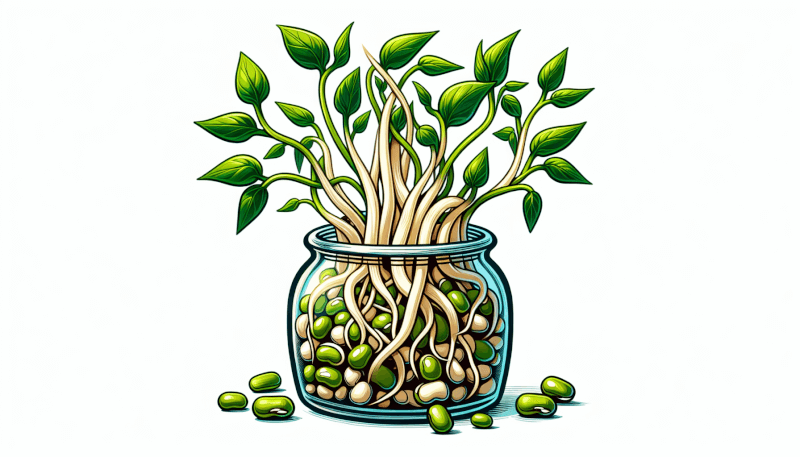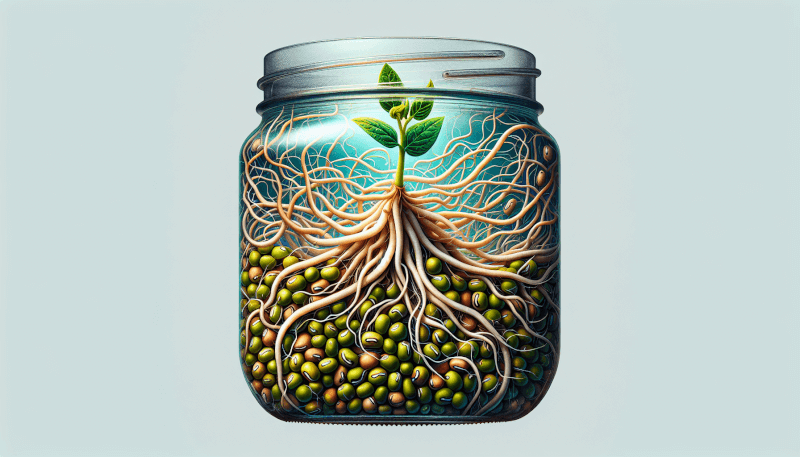👋 Click the mic button to talk to Alfred, the Todd's Seeds Gardening/Sprouting Expert – Feel free to ask him anything!
Ask Virtual Todd Anything - Click the Mic
Ready to add a touch of freshness to your meals? Look no further than this step-by-step guide to sprouting mung beans in a jar! Sprouting mung beans not only enhances their nutritional value, but also adds a delightful crunch and delicate flavor to your salads, stir-fries, and wraps. In this guide, you’ll discover the easy and rewarding process of sprouting mung beans right in the comfort of your own kitchen. With just a few simple steps and a bit of patience, you’ll soon be enjoying your own homegrown sprouts that are overflowing with vitality and goodness. Let’s get sprouting!

A Step-By-Step Guide to Sprouting Mung Beans in a Jar
If you are looking to add some nutritious and crunchy sprouts to your salads or sandwiches, sprouting mung beans in a jar is an easy and fun process that you can do at home. With just a few simple materials and a little bit of patience, you can enjoy fresh sprouts that are not only delicious but also packed with vitamins and minerals. So, let’s get started!
Materials Needed
Before diving into the sprouting process, make sure you have the following materials on hand:
Mung beans
Mung beans, also known as green gram, are the star of this sprouting adventure. They are small, green legumes that are commonly used in Asian cuisines. You can find them easily at your local grocery store or purchase them online.
Glass jar with a lid
Choose a glass jar that is large enough to hold a sufficient amount of beans. It should have a wide mouth for easy rinsing and drainage. Make sure the jar has a lid to prevent any unwanted contamination during the sprouting process.
Water
Good old H2O is the essential ingredient for sprouting mung beans. Ensure that you have access to clean and filtered water, as it will directly affect the quality of your sprouts.
Now that you have gathered the necessary materials, let’s proceed with the step-by-step guide on sprouting mung beans in a jar.

Preparation
Before we dive into the sprouting process, there are a few important preparatory steps to follow.
Selecting the beans
Inspect the mung beans and discard any discolored or damaged ones. Select high-quality beans, as this will greatly impact the final taste and texture of your sprouts.
Cleaning the beans
Give the selected beans a good rinse under cold water to remove any dirt or debris. Be thorough and make sure all the beans are clean before proceeding to the next step.
Soaking the beans
Place the cleaned beans in a bowl or the glass jar and add water until they are fully submerged. Let them soak for about 8-10 hours or overnight. Soaking helps to soften the beans and initiate the sprouting process.
Sprouting Process
Now that the beans are properly prepared, it’s time to kickstart the sprouting process.
Rinsing the soaked beans
After the soaking period, drain the water and rinse the beans again under cold running water. This helps to remove any residual impurities and activates the sprouting process.
Draining the water
Once the beans are rinsed, make sure to drain out all the excess water. You want to keep the sprouts moist but not waterlogged. Tilt the jar at an angle to facilitate proper drainage.
Placing the beans in the jar
Transfer the drained beans back into the glass jar. Spread them out evenly to allow sufficient room for sprouting. Avoid overcrowding the jar, as this can hinder proper air circulation, resulting in mold growth.
Covering the jar
Place the lid loosely on top of the jar. This is important to allow air circulation while preventing any unwanted pests or contaminants from entering the jar.
Rinsing the sprouts
Every 8-12 hours, rinse the sprouts with water. Use gentle and circular motions to ensure all the sprouts are adequately washed. This process helps to keep the sprouts clean and hydrated.
Repeat rinsing process
Continue rinsing the sprouts twice a day for the next 3-5 days, or until they reach the desired sprout length. This will vary depending on your preference, but typically mung bean sprouts are ready within 4-6 days.
Providing air circulation
During the sprouting process, make sure the sprouts have access to fresh air. Keep the jar in a well-ventilated area, away from direct sunlight and extreme temperatures. This will help promote healthy and robust sprout growth.
Checking for mold
Regularly inspect the sprouts for any signs of mold growth. If you notice any mold, discard the entire batch as it can be harmful to consume. Mold growth can occur due to inadequate rinsing, poor air circulation, or excess moisture, so be mindful of these factors.
Harvesting and Storing Sprouts
Once your mung bean sprouts have reached the desired length, it’s time to harvest and store them for future use.
Determining maturity
Mung bean sprouts are typically ready for harvest when they reach about 1-2 inches in length. At this stage, they will be crisp and crunchy, perfect for adding to your favorite dishes.
Harvesting the sprouts
To harvest the sprouts, remove them carefully from the jar using clean hands or a fork. Gently separate the sprouts from the remaining beans or seed hulls and discard any undesired components.
Storing the sprouts
Store the harvested sprouts in a clean container lined with a paper towel or a dry cloth to absorb excess moisture. Place the container in the refrigerator, where they can stay fresh for up to a week. Remember to rinse the sprouts before each use to maintain their freshness.
Tips and Troubleshooting
While sprouting mung beans is a straightforward process, here are a few tips to ensure the best results and troubleshoot any issues that may arise.
Using organic mung beans
Whenever possible, opt for organic mung beans. Organic beans are free from harmful pesticides and chemicals, ensuring a safer and healthier sprouting experience.
Avoiding direct sunlight
Direct sunlight can cause excessive heat, leading to wilted and damaged sprouts. Keep the sprouts in a shaded area with indirect light to maintain their quality.
Avoiding over-soaking
Over-soaking the beans can lead to waterlogged sprouts and unpleasant taste. Stick to the recommended soaking time of 8-10 hours or overnight for optimal results.
Preventing mold growth
Proper rinsing and drainage are crucial to prevent mold growth. Make sure to rinse the sprouts thoroughly and drain off any excess water to maintain a suitable environment for sprouting.
Troubleshooting common issues
If you encounter any issues such as foul smell, sliminess, or discoloration, it may indicate bacterial contamination. In such cases, it is best to discard the sprouts and start a new batch with extra caution in terms of hygiene and cleanliness.
With this step-by-step guide, you are now equipped with the knowledge and techniques to successfully sprout mung beans in a jar. Remember to practice good hygiene, regular rinsing, and proper airflow to ensure healthy and delicious sprouts every time. Enjoy the benefits of homegrown sprouts and elevate your culinary creations with a touch of freshness and nutrition!


